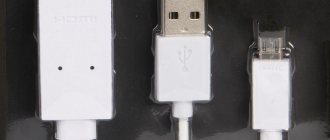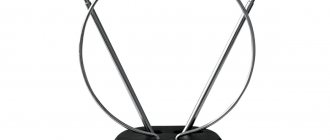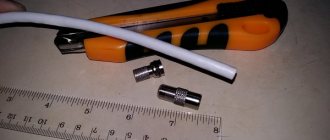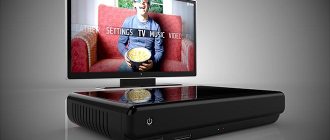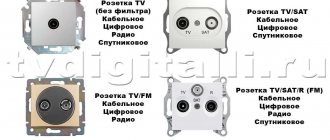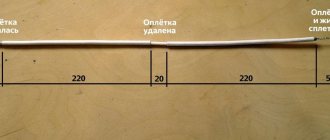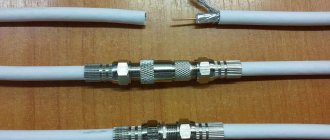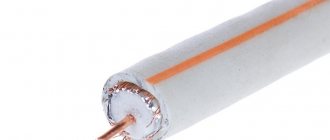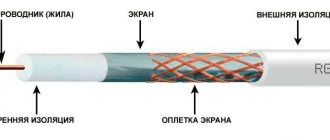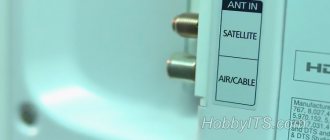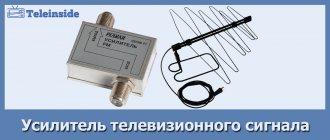Connecting television equipment is a simple matter. But this is at first glance. In fact, even experienced technicians sometimes get confused when it comes to choosing an antenna cable for a TV. Marking, thickness, technical characteristics - all this must be taken into account to make the right choice. We suggest studying all the nuances of this issue.
- Coaxial cable for TV - brands and characteristics
RG-6
- RK 75
- RG 59
- SAT 50
- SAT 703
- DG 113
- Installation and operation
Cable bending problems
- Which cable is better to choose?
- In conclusion
The structure of a television cable
Absolutely all models of such products have similar content. The components are:
- Inner conductor. It can be made in the form of a single or multi-core wire, as well as a copper tube. Multi-core products are characterized by a greater degree of elasticity and endurance. It can be all copper or copper coated steel.
- Dielectric layer. Provides static position of conductors. The material used for its manufacture is usually polyethylene, fluoroplastic or foamed polyvinyl chloride. Foamed dielectric provides greater flexibility. The only negative is the absorption of moisture, which significantly impairs the functional characteristics.
- Outer conductor, or braid. Has an insulating function. Can be made of foil, corrugated tube, aluminum film, metal wire. Protects the conductor from third-party negative radiation, or electromagnetic interference (EMI).
- Shell. Protecting the internal structure of the wire from the negative influences of climatic and chemical nature.
Coaxial cable for TV
A cable of this structure is also called coaxial . Therefore, everything that is written in this article will help you understand which is the best coaxial cable to buy for your TV.
Let's sum it up
If the time has come to choose, it is better to choose the cable that fulfills all the mentioned conditions:
- the thickness of the inner core exceeds 1 mm;
- the shielding film is glued to a physically foamed dielectric;
- has triple or quadruple insulation;
- braid density of at least 64% (densely spaced wires with a thickness of at least 0.12 mm);
- the coating of the outer insulating layer is adapted to the purpose of the cable;
- the maximum attenuation at frequencies of 862 MHz and 2150 MHz is respectively lower: 21 dB and 32 dB (parameter for 100 meters of wire).
By choosing an antenna cable according to these rules, you can be sure that you are dealing with an excellent quality product that you can count on when installing cables for both analogue and digital TV.
Which cable to choose for satellite, digital, cable TV
Direct connection to television equipment does not cause problems or difficulties in selecting the desired type of product. However, a number of older models are not equipped with decoders. For this reason, to watch digital television, you will need to connect a digital receiver. In addition, you need to find a cable to connect the set-top box directly to the TV.
Modern receivers have connectors of various formats, which means a wide selection of cables. They share one important characteristic. We are talking about throughput - it is what is responsible for the maximum image clarity that the wire from the receiver can provide after decoding the digital signal. In other parameters the products are different.
Experts say that purchasing a cord for each type of television is unprofitable. This is due to the fact that the frequencies of such channels do not differ much from each other and fit within the range of 49-800 MHz. Such a gap is qualitatively “covered” by absolutely all types of brands SAT 50, RG 6, SAT 703, DG 113 and RK 75 . If the total wiring length ranges from 20 to 30 meters, feel free to buy one type of product.
Coaxial Cable Specifications
Antenna wire for satellite television
The broadcast frequency of satellite channels ranges from 1-3 GHz, which is extremely different from analog television. They are more susceptible to interference and require effective shielding. In addition, the frequency of data receipt is higher. Focus on the task that the cable must perform - transmit a signal without significant losses. To do this, it must be wider and equipped with an outer shell that is resistant to various weather conditions.
For satellite television, it is recommended to consider values exceeding the optimal characteristics, for example, SAT 50, SAT 703, DG 113.
Marking
When you buy a domestic product, there are usually no difficulties with its designation.
- RK – radio frequency cable;
- 75 – conductor resistance 75 Ohm;
- 4.8 – diameter;
- 34 – the first digit shows the insulation group, heat resistance category. The second digit is the serial number of the development;
- TU – technical manufacturing conditions.
But the labeling of imported cables can be confusing. Meanwhile, here is the definition of Western standards:
- DELINK – manufacturer;
- SAT-752 – name;
- Cu/Cu – material of the central conductor and braid (Cuprum – copper);
- 1.13 – thickness of the central core;
- 0.12*64 – thickness and density of the braid;
- Cu-foil – full copper;
- Coaxial cable – coaxial cable;
- 75 OHM – conductor resistance 75 Ohm;
- ISO 9001—2000 – certificate of conformity.
Coaxial cable for TV - brands and characteristics
Similar products are produced under various manufacturer brands. However, absolutely all of them have a characteristic impedance of 75 Ohms and are suitable for connecting one or more devices. Read more about the most famous and in demand cables.
RG-6
Produced in Russia. Consists of two cylindrical conductors. The central core is made of copper-plated steel with a thickness of 1.0 mm, covered with polyethylene foam. Shielding - foil and steel braiding. Protective PVC shell. The nominal wire diameter is 6-6.8 mm. Attenuation at 1750 MHz – 26.5 dB/100 m. Average price – from 10 rubles/m.
RG-6 cable
RK 75
Analogue of RG-6 of domestic production. The copper central core is single-wire, thickness 1.0 mm. The insulating material is porous PE of physical foaming. The screen is made of copper braid or aluminum lavsan and tinned copper. The minimum cost per meter is 10 rubles.
Cable RK 75
RG 59
Analogue of RG-6, consisting of two cylindrical conductors. The central core is made of copper-plated steel. Thickness – 0.5-0.58 mm. The material of the internal dielectric is foamed polyethylene, the screen is foil and steel braid. Outer diameter: approximately 6.0 mm. The average price is 8 rubles/m.
Cable RG 59
SAT 50
It can handle all types of TV signals. Manufacturer: Cavel, Italy. The central single-wire core of soft copper reaches a diameter of 1.0 mm. The reinforced screen is made of foil and copper-tin braiding, the shielding coefficient is from 60 dB. The conductor is covered with high-strength polyethylene foam, the outer sheath is PVC. Overall diameter up to 6.6 mm. Fireproof, can be used indoors and outdoors. Cost – 30 rubles/m.
SAT 50 cable
SAT 703
Copper central core 1.13 mm thick. Shielding material is aluminum-plastic foil and copper-tin braid (80 dB or more). Covering made of PEG dielectric and PVC, total thickness – 6.6 mm. Transmits any TV signal with high quality. Issue price – from 40 rub/m
SAT 703 cable
DG 113
Technical standards are close to SAT 703. An excellent option for a satellite dish inside a building. The wire has a high shielding value - from 90 dmb, which facilitates the transmission of high quality impulses. Failures and interference in operation are practically excluded. The average service life is more than ten years. It is considered the most expensive - from 65 rubles per meter.
Cable DG 113
The best antenna splitters for 2 TVs
To connect multiple TVs at once, use the best TV splitters. Let's look at them in more detail below.
PROconnect
This splitter is a coaxial option for satellite television with various quality characteristics. It can not only be used for two TVs, but also for interconnection and interconnection in public places. Can also be used to connect household radio devices or various types of surveillance cameras.
High-quality materials are used for production, which ensure stable data transmission without interference or distortion.
The outer covering is made of polyvinyl chloride, so you can install the splitter outdoors. It does not deform under the influence of ultraviolet radiation.
The length can be about 10, 20 and 50 m. There is a plug on each side for connection.
REXANT
This splitter model is used to connect several TVs or surveillance cameras. Total length – 100 m.
The splitter is characterized by high-quality insulation. Polyvinyl chloride was used for its manufacture. Black color. The disadvantage of this model is that it does not have connectors.
Now you know which antenna cable for satellite television is best to choose. It all depends on the installation location, the distance between the receiver and the receiver, the required signal quality, and price.
A lot of interesting information is on the video.
Installation and operation
The antenna cable for the TV is quite resistant to external factors. If there are fluctuations in temperature outside, you should opt for a wire with a steel core, due to its low thermal conductivity. Indoors, on the contrary, it is better to use a copper core. It is extremely important to take into account such nuances, since resistance increases with heating. It helps reduce signal speed. Even the densest double screens offer negligible attenuation rates. So, you need to reduce the distance between the antenna and the TV tuner or purchase an amplifier. In this case, the power consumption of the receiver increases.
Correct installation of coaxial cable for a TV
Modern receivers include fasteners and clamps for simplified connection. However, the most reliable and proven installation method is soldering.
Cable bending problems
One or another bending option implies a significant deterioration in the signal level. This can be avoided by placing the cord at an angle of 90°. However, this increases the absorption of the wire and the risk of destruction of the screen at this point.
Experts recommend, if possible, to avoid sudden changes in the shape of the product. You should adhere to a smooth change of direction within the limits of acceptable flexibility.
What is important when choosing
The choice of cable for a TV antenna is based on 7 main factors:
- Outer shell material. In the production of feeders, two options are used - PVC and light-stabilized (that is, resistant to ultraviolet rays) polyethylene. PVC is ideal for use inside an apartment (for example, when connecting to a communal antenna or cable TV). But for external laying nothing better than polyethylene has yet been invented. An unsuitable type of coating will lead to cable damage and breakdown.
- Strength of the outer layer. It is enough to try the outer PE or PVC sheath on a section of the feeder by pulling it towards you. If it moves easily, there is no need to use the cable: bending may damage the screen.
- The length of the route along which the cable channel will pass. The longer, the greater the loss of signal power due to conductor resistance. Therefore, where you need to lay a long route (10 m or more), it is better to use a cable with a copper central core rather than a steel one;
- Incoming signal power. Reception of terrestrial relay television broadcasts of the DVB-T2 standard provides the equipment with sufficiently powerful impulses, the same applies to cable TV. But the signal strength coming from the satellite is low. Therefore, for dishes it is better to choose cables with a copper core.
- Diameter of the central core. The thicker it is, the less loss during signal transmission. However, conductors that are too thick may require special adapters in order to be used in standard connectors.
- Cable thickness. Typically, the more powerful the feeder, the more layers of shielding are used, the thicker the central core and the more reliable the insulation. However, this is only an indicative sign. A high-quality, thin cord may be better suited for installation than a thick, low-quality cord. We'll talk about this below.
- Material of the central core. Copper transmits the signal better, clad steel is stronger. It’s easy to check what the core is made of: you need to take a magnet and bring it to the cable. If there is attraction, it means steel, if there is no attraction, it means copper.
Additionally, you can look for the following signs:
- Reviews of specific brands. It’s better to look at TV master forums rather than in online stores: there’s a greater chance that a particular review was not paid for, but was compiled on the basis of practical experience.
- Manufacturer. There are several brands whose products have no complaints (for example, the Italian company Cavel). For others, you need to look at the parameters of a specific brand.
Which cable is better to choose?
A similar question is often asked by buyers who want to connect television equipment themselves.
The huge range of cable products that are currently on the market is often “diluted” with low-quality products made from poor raw materials. This causes various problems associated with signal transmission.
When purchasing, it is important to consider both the characteristics and type of cable, as well as the type of television equipment being connected. So, experts recommend:
- use cables for digital television in apartments, since their bandwidth is many times greater (on any range);
- purchase cords with special impregnation for their further use in adverse weather conditions;
- make a minimum number of connections and solders and try to stretch a solid wire;
- Do not lay the coaxial cable near electrical wires (broadcast interference may occur).
If we are talking about a specific company, then Cavel deserves attention. Antenna cables produced by it have long established themselves as products of high quality and long service life. Such products are thicker, stronger than analogues, resistant to mechanical stress and easy to install. All connections to sockets, plugs, etc. provide excellent contact. The guarantee of long service life is the high-quality materials used in production.
Choosing quality
So how will you check the cable quality? According to the following seven signs!
Purpose
External insulation not only resists external influences and mechanical damage - what it is made of largely determines the properties of the cable wire.
The most commonly used polyvinyl chloride coating for cable cords. You can choose them for wiring in the apartment. The coating made of light-stabilized polyethylene distinguishes the cords for outdoor use. In addition, outdoor cables have a protective gel-like layer against weather conditions and sunlight. By removing a section of insulation, you can see if there is a gel-like lubricant underneath that protects the inner surface of the cable from moisture.
Outer shell strength
Just try removing the outer layer by hand. If the PVC or PE coating is weak and easily slides off the braid or foil layer, lengthening and stretching, this no longer guarantees sufficient cable strength.
Quality of the shielding layer
The shielding layer is aluminum or copper foil wound onto a dielectric. Its task is to protect the signal passing inside the cable from external electromagnetic waves that can cause interference. It also prevents the signal from leaking out to prevent it from weakening. For both conditions to be met, the foil must be glued to the dielectric layer. This can be easily checked by removing part of the shell and examining the shielding layer. If the foil moves freely along the dielectric layer, this means that it was not glued, which means that during installation, when you need to bend the wire properly, the film will slightly open the dielectric and create an unprotected “gap” through which signals will penetrate.
You may be interested in: What does an HDMI cable look like?
Braid density
The most common braid is a copper or aluminum mesh made of wire with a diameter of about 0.12 mm. The higher the braid density (more wires), the higher the electromagnetic density of the cable. This is another barrier to protect the transmitted signal from interference.
At first glance, the density of the weave is difficult to assess. Pay attention to the interweaving of the hairs, at what angle? If they are laid freely, longitudinally, then we are dealing with a thin braid. And vice versa, if they form a dense mesh that covers the entire wire, then the braid coating is dense, “airtight”. The signal will be under reliable protection.
Dielectric check
The dielectric is a polymer layer made mainly of polyisobutylene. It is important that this material is foamed in a physical way. Chemical foaming does not have a long-term effect - after a few years the dielectric will collapse. A fragile dielectric means there is a 100% risk of displacement of the central core and loss of coaxiality. You cannot use such a wire for digital television.
Unfortunately, the nature of such foaming is difficult to analyze without special tools. But is it possible to check whether the dielectric is dense and whether it is well “welded” both to the core and to the foil (screen)? This is of key importance when bending the cable and determines its permissible bend radius.
Coax class
The cable class characterizes the degree of electromagnetic leakage. The higher the class, the greater its density and resistance to external interference. Higher tightness is achieved by choosing the type and number of screens and braids used. Cable wires are distinguished:
- two-layer – two layers inside: foil + braid;
- three-layer – foil + braid + foil;
- four-layer – braid + foil + braid + foil.
Of course, the greater the number of layers, the greater the electromagnetic density, the higher the class and quality of the cable wiring. To choose the right television cable, you need to see what class we are dealing with. It is enough to “clean” it layer by layer, reaching the dielectric.
Core type and thickness
The type of inner core and its thickness are directly related to the signal attenuation in the cable. Low attenuation cables maintain adequate signal quality throughout the entire length to the receiving device.
Coaxial cores can be made of copper or copper-plated steel. Copper has better conductive properties and reduces resistance to electrical charges. Therefore, it is more often used in various types of cables. In turn, the diameter of the wire increases the active conducting surface and reduces the resistance to these charges.
If the core is soft and does not change color after a small scrape or cut, you can be sure that you are dealing with copper wire. However, if the center wire is rigid, and after cleaning the top layer of copper the silver color of the steel clearly appears, then you have a copper-plated wire.
You may be interested in: Lightning protection for antenna
